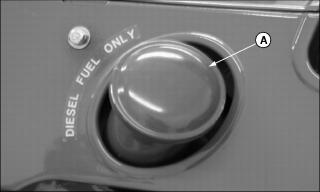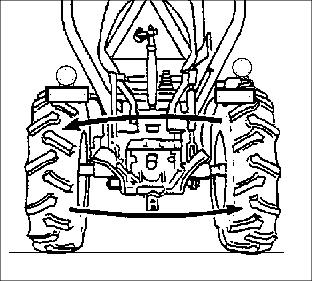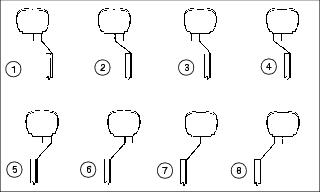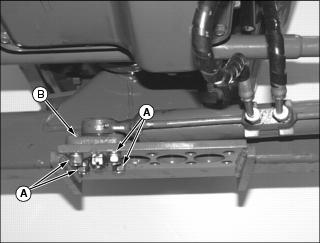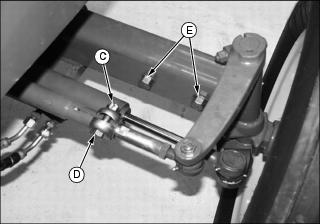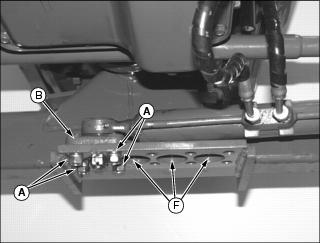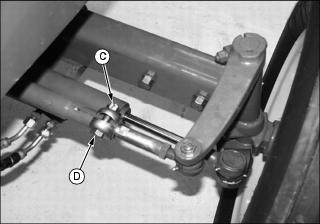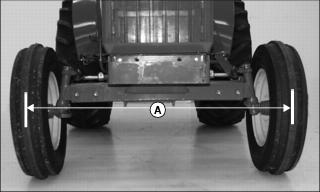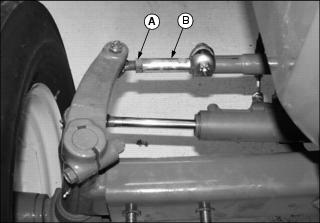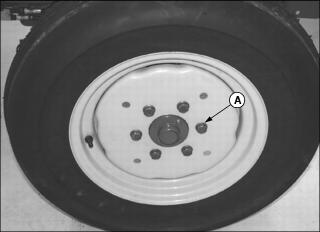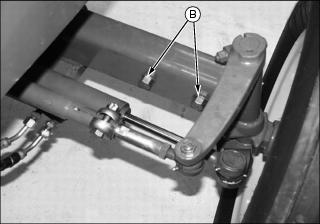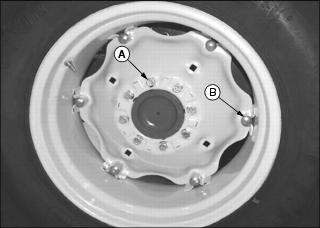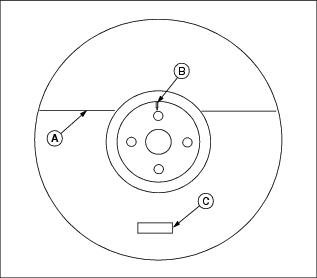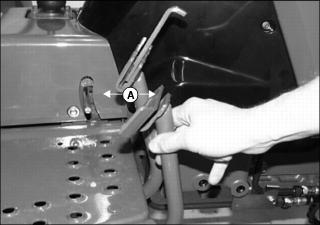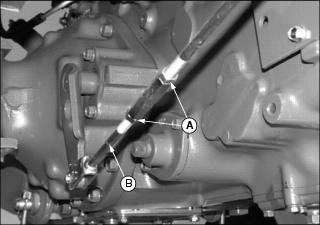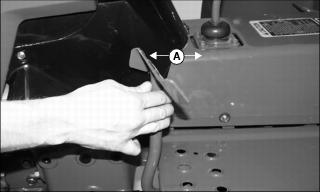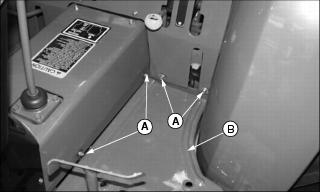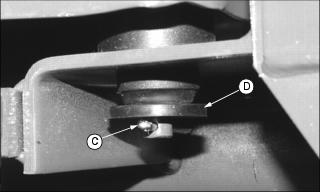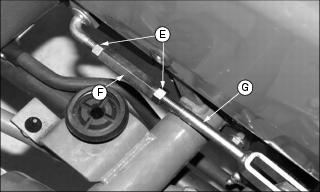Compact Utility Tractor with Gear Transmission
Introduction
Product Identification
Safety
Operating
Replacement Parts
Service Intervals
Service Lubrication
Service Engine
Service Transmission
Service Electrical
Service Miscellaneous
Selecting Front Tire Rolling Direction
Changing Wheel Spacing and Tread Width
Cleaning and Repairing Metal Surfaces
Troubleshooting
Storage
Assembly
Specifications
Warranty
John Deere Quality Statement
Service Record

Service Miscellaneous
Diesel Fuel Specifications
In general, diesel fuels are blended to satisfy the low air temperature requirements of the geographical area in which they are sold.
Diesel fuel is usually specified to ASTM D975 and sold as either Grade 1 for cold air temperatures or Grade 2 for warm air temperatures.
If diesel fuels being supplied in your area DO NOT meet any of the above specifications, use diesel fuels with the following equivalent properties:
· Cetane Number 40 (minimum). A cetane number greater than 50 is preferred, especially for air temperatures below -20°C (-4°F) or elevations above 1500 m (5000 ft).
· Cold Filter Plugging Point (CFPP). The temperature at which diesel fuel begins to cloud or jell. Use diesel fuels with a CFPP which is at least 5°C (9°F) below the expected low air temperature.
· Sulfur Content of 0.05% (maximum). Diesel fuels for highway use in the United States now require sulfur content to be less than 0.05%. If diesel fuel being used has a sulfur content greater than 0.5%, reduce the service interval for engine oil and filter by 50%.
Bio-Diesel Fuels with bio-degradable properties that meet specification DIN 51606 or equivalent may be used.
Consult your local diesel fuel distributor for properties of the diesel fuel available in your area.
Diesel Fuel Lubricity
Diesel fuel must have adequate lubricity to ensure proper operation and durability of fuel injection system components. Fuel lubricity should pass a minimum of 3300 gram load level as measured by the BOCLE scuffing test.
Fuel Storage
It is recommended that diesel fuel be stored ONLY in a clean, approved POLYETHYLENE PLASTIC container WITHOUT any metal screen or filter. This will help prevent any accidental sparks from occurring. Store fuel in an area that is well ventilated to prevent possible igniting of fumes by an open flame or spark. This includes any appliance with a pilot light.
Keep fuel in a safe, protected area and in a clean, properly marked ("DIESEL FUEL") container. DO NOT use de-icers to attempt to remove water from fuel. DO NOT use de-icers to attempt to remove water from fuel. It is recommended that a water separator be installed in the storage tank outlet. BE SURE to properly discard unstable or contaminated diesel fuel and/or their containers when necessary.
Filling Fuel Tank
2. Fill fuel tank at end of each day of operation to prevent condensation in fuel tank as moist air cools.
3. Fill fuel tank when fuel gauge shows 1/4 or less fuel in tank.
Selecting Front Tire Rolling Direction
Tractors equipped with directional type tires (such as bar tires) have directional arrows (A) located on the tire sidewall. Under most conditions, tires should be installed with the directional arrow pointing in the direction of travel.
If tractor is mainly used for loader operations, lug direction may be reversed to increase tire life and improve traction while backing out of dirt piles.
Move wheel from one side of tractor to the other.
Changing Wheel Spacing and Tread Width
The front and rear wheels can be mounted in WIDE or NARROW positions to increase or decrease wheel spacing. To provide best stability, operate tractor with rear wheels mounted in the wide tread position whenever possible.
Front Wheel Positions:
· WIDE POSITION - Install wheel with valve stem to the inside.
· NARROW POSITION - Install wheel with valve stem to the outside.
Rear Wheel Positions:
· WIDE POSITION - Install wheel with valve stem to the outside.
· NARROW POSITION - Install wheel with valve stem to the inside.
The mounting flanges on the rear rims are closer to one edge of the rim than the other, allowing the inner wheels to be mounted in different positions. By changing this position of the wheel on the rim, up to eight different tread widths can be achieved on some tractors.
Various positions cannot be used because the tires would strike the fenders. Certain other positions may result in equal tread widths.
The front wheel spacing can be adjusted to eight different tread widths by reversing the front wheels and by extending the front axle.
Tread width is measured from centerline-to-centerline of each tire.
Mounting Guidelines
· To keep tire rotation in the proper direction when wheels are reversed without demounting rims, move each wheel to the opposite side of the tractor.
· Rims can be attached to either side of wheel.
· Mounting flanges on rim are closer to one edge of rim.
· Tread width can be changed by turning the wider side in or out.
· To keep tire rotation in the proper direction, move each rim to opposite side of tractor, rather than turning the rims around.
· Dished wheels can be reversed.
· Tighten all bolts to specifications.
Rear Tire Tread Width Dimensions
Front Tire Tread Width Dimensions (2WD Tractors)
Front Tire Tread Width Dimensions (MFWD Tractors)
Adjusting Front Axle Width
Adjust front axle width as needed to achieve desired front tire tread width.
1. Park machine safely. (See Parking Safely in the SAFETY section.)
2. Raise front of tractor with a safe lifting device. Install blocks or safety stands under front frame. Lower tractor onto blocks or stands.
4. Remove four bolts and lock washers (A).
5. Lift power steering cylinder and attached block (B) out of hole in mounting plate so it can move accordingly when front axle is extended.
6. Remove cotter pin and nut (C) from tie rod clamp bolt at right side of tractor. Remove tie rod clamp bolt (D).
NOTE: Tie rod and power steering cylinder will self-align to the proper width position as axle is extended.
8. Pull outward on right side wheel assembly to extend the inner axle channel to the desired width. Holes (E) must align with holes in inner axle channel.
9. Install axle bolts (E). Tighten bolts to 260 N·m (190 lb-ft).
NOTE: Steering cylinder block will be self-aligned with one of the adjustment holes (F) in the mounting plate.
10. Seat block (B) into appropriate adjustment hole (F) in mounting plate.
11. Install four bolts and lock washers (A). Tighten bolts to 78 - 98 N·m (58 - 72 lb-ft).
12. Install tie rod clamp bolt (D). Make sure bolt is seated in adjustment notch in tie rod.
13. Install and tighten nut (C). Secure with cotter pin.
NOTE: Power steering cylinder is adjusted when changing the right front axle. Do not move cylinder when adjusting left front axle.
14. Adjust left front axle in the same manner.
15. Raise front of tractor with a safe lifting device.
16. Remove blocks or stands from under tractor.
19. Check the toe-in setting. Adjust if needed.
Checking and Adjusting Toe-In
1. Stop tractor on a firm, level surface.
2. Disengage MFWD if equipped.
3. Turn steering wheel so front wheels are pointing straight ahead.
4. Park machine safely. (See Parking Safely in the SAFETY section.)
Checking Toe-In
NOTE: If front axle is equipped with bar tires, use an outside bar of each tire or an inside bar of each tire for marking the centerline.
1. Mark the centerline of each tire at hub height and to the front of the axle using chalk.
2. Measure distance (A) between the centerlines of each tire. Record the measurement.
3. Drive tractor forward or rearward slightly until chalk mark moves 180° to the rear of the axle.
4. Park machine safely. (See Parking Safely in the SAFETY section.)
5. Measure distance (A) again between the chalk marks. Record the measurement.
6. Determine the difference between front and rear measurements:
NOTE: If front measurement is smaller, toe is "IN." If rear measurement is smaller, toe is "OUT."
· 2WD Tractors - Distance (A) at front of tires should be 3 - 6 mm (1/8 - 1/4 in.) less than distance at rear of tires. If not, adjust toe-in.
· MFWD Tractors - Distance (A) may be larger at front or rear measurement but should not exceed 3 mm (1/8 in.). Adjust toe-in if necessary.
Adjusting Toe-In
1. Loosen tie rod nut (A) on both tie rod ends.
2. Turn tie rod (B) until toe-in is within correct specification.
3. Tighten both tie rod nuts completely.
Checking Wheel Bolt Torque
Anytime hardware is loosened, it MUST be retightened to specified torque. Check wheel bolt torque as follows:
· After driving tractor about 100 m (109 yd), and before placing it under load, retighten hardware to specified torque.
· Check hardware after operating tractor for 3 hours and again after 10 hours.
· Check all hardware frequently and keep it tight.
Front Wheel Bolts
Tighten front wheel disk-to-flange bolts (A) to 155 N·m (114 lb-ft).
2WD Tractors Only: Tighten front axle bolts (B) to 260 N·m (190 lb-ft).
Rear Wheel Bolts
Tighten rear wheel disk-to-flange bolts (A) to 155 N·m (114 lb-ft).
Torque the rear wheel rim-to-disk bolts (B) to 240 N·m (177 lb-ft).
Checking Tire Pressure
NOTE: If tire is liquid filled (A), always keep valve stem (B) at top of tire when checking air pressure. This prevents liquid from escaping through valve stem.
Maximum tire pressure (C) is embossed into tire side wall.
2. Check tire pressure with an accurate gauge.
Front Tire Inflation Pressures
Rear Tire Inflation Pressures
Checking and Adjusting Brakes
1. Stop machine on a level surface. Do not lock park brake.
2. Leave machine in gear. STOP engine and remove key.
Checking Brake Adjustment
1. Pull down on each brake pedal and measure the free travel distance (A) that the pedal pivots from top of stroke to the point before brake engagement occurs.
2. Adjust both brakes if free travel for either pedal is greater than 35 mm (1-3/8 in.) or if it is not the same for both pedals.
Adjusting Brakes
1. Loosen linkage rod lock nuts (A).
NOTE: If brake linkage has no adjustment remaining, see your John Deere dealer for service.
2. Rotate turnbuckle (B) to shorten length of rod (C) so pedal free travel is 25 mm (1 in.).
3. Tighten the lock nuts completely.
4. Repeat for other brake pedal. Adjust to same distance.
Checking and Adjusting Clutch
Checking Clutch Adjustment
1. Pull down on clutch pedal and measure the free travel distance (A) that the pedal pivots from top of stroke to the point before clutch engagement occurs.
2. Adjust clutch if free travel is greater than 25 mm (1 in.).
Adjusting Clutch
1. Remove screws and flat washers (A) from panels to provide clearance for removal of left footwell plate (B).
2. Remove cotter pin (C) and rubber washer (D) from three locations at bottom side of footwell plate.
3. Lift and remove footwell plate from tractor.
4. Loosen linkage rod lock nuts (E).
NOTE: If clutch linkage has no remaining adjustment, see your John Deere dealer for service.
5. Rotate turnbuckle (F) to shorten length of rod (G) so pedal free travel is 15 - 25 mm (5/8 - 1 in.).
6. Tighten the lock nuts completely.
Cleaning and Repairing Metal Surfaces
Cleaning
Follow automotive practices to care for the painted metal surfaces of your tractor. Use high-quality automotive wax regularly to maintain the factory appearance.
Repairing Minor Surface Scratches
1. Clean area to be repaired thoroughly.
2. Use automotive polishing compound to remove surface scratches.
3. Apply wax to entire surface.
Repairing Deep Scratches
To repair deep scratches showing bare metal or primer:
1. Clean area to be repaired with rubbing alcohol or mineral spirits.
2. Use paint stick with factory-matched color to fill scratches. Paint sticks are available from your John Deere dealer.
3. Smooth out surface using an automotive polishing compound. Do not use power buffer.

